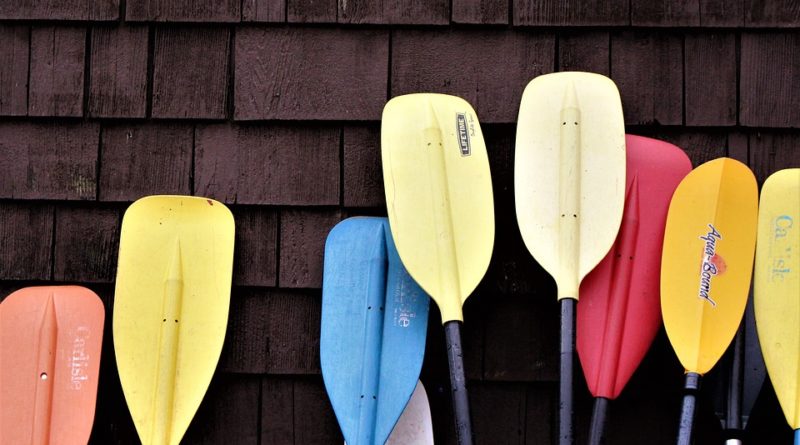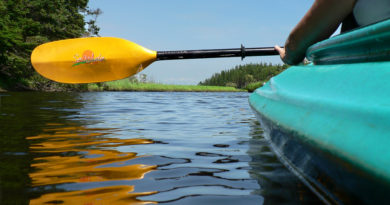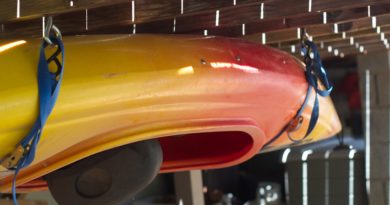How to Choose a Paddle
This post contains links to purchase items, and we may qualify for a commission if you use that affiliate link.
Kayak paddles are probably the most important pieces of equipment next to the kayak itself. Without them, kayaking wouldn’t be too much fun and you wouldn’t get very far. There are so many options when purchasing kayak paddles, but choosing the right one isn’t too difficult. We’ll break down the basics here and help demystify kayak paddles by explaining the following categories:
- Paddle length
- Materials
- Shaft style
- Blade angle
- And a few other considerations
Paddle Length
The first thing you should consider when purchasing a paddle is the length. The length is based primarily on two factors: the width of the kayak, and the height of the paddler. The following chart from Aquabound is a great reference for finding the right size:
| Paddler Height | Kayak Width | |||
|---|---|---|---|---|
| Under 23″ | 24″ to 28″ | 29″-33″ | 34″+ | |
| Under 5’5″ | 210 cm | 220 cm | 230 cm | 240 cm |
| 5’5″ – 5’11” | 220 cm | 230 cm | 240 cm | 250 cm |
| 6’+ | 220 cm | 230 cm | 250 cm | 260 cm |
If you find yourself between sizes, it’s usually better to go with the shorter length. You’ll find it won’t make much of a difference and you may save some weight on your gear.
Materials
Blades
There are really only 3 categories of materials that blades are made of. Each have their advantages and disadvantages, and of course their price range. In order to figure out which blade is best for you ask yourself the following questions: How often will I kayak? How long will I kayak for? What kind of water will I be in? What can I afford?
Each of the materials below have a different weight, a different amount of flex, and a different cost. You want to get a good balance of weight and rigidity to be efficient.
Plastic/Nylon
There are multiple names for plastic blades including “polymer” or “polypropylene,” so don’t fall for any marketing tricks or let someone talk you into a more expensive plastic blade. While they are the cheapest material for blades, plastic has some disadvantages. Plastic is the most flexible blade material, which sacrifices power and efficiency on your stroke. Plastic is also heavier than fiberglass or carbon-fiber. While it may not seem like it will matter, after a long day of kayaking, that little bit of weight makes a big difference. Keep in mind that when you paddle, you raise the blade higher than the shaft and it’s at the very end, so weight can be a bigger factor than you think. Also, plastic tends to degrade and crack when it’s exposed to the sun for a long time. Even with all those disadvantages, plastic is still a fine choice for someone just starting out or who doesn’t plan to kayak all that often.
This paddle from Pelican is a great example of a budget-friendly paddle with plastic blades.
Fiberglass
Next on the list is fiberglass. It’s also middle of the price range. Fiberglass is lighter and more rigid than plastic, making it quite a step up in performance and efficiency. If you find yourself kayaking more often than you thought, take a look at fiberglass blades.
Carbon-fiber
Last, but certainly not least, is carbon-fiber. By far the most expensive blade material, carbon-fiber is extremely light, rigid, and out-performs both plastic and fiberglass. The strength of carbon-fiber ensures you get the most power with every stroke, and it’s weight allows you to paddle with ease. As mentioned, carbon-fiber is a lot more expensive. But, if you can afford it, carbon-fiber won’t let you down.
Shafts
The difference in shaft materials doesn’t affect performance as much as the blade materials do. Although they’re not as common, plastic shafts should be avoided. They can crack, flex, and degrade. The more common materials for shafts are aluminum, fiberglass, and carbon-fiber. As you can probably guess, those materials were listed in order of price and performance. However, unlike plastic, aluminum offers great performance for the price and is a great budget-friendly option. The only real advantage fiberglass and carbon-fiber have is their weight.
As an example, this Aqua-Bound paddle is a great option. It’s a good example of a mid-range paddle, featuring plastic blades with fiberglass reinforcement, and a lightweight carbon-fiber shaft. It can also be changed from matched to feathered, which is explained further down.
Shaft Style
There are a few considerations to make when choosing a shaft style. Shafts come in bent, straight, feathered, matched, two-piece, and four-piece. Shafts can be a combination of any of these styles, and each are really just a matter of preference more than anything.
Bent vs Straight
Straight shafts are the most common. Bent shafts on the other hand have kinks in them which allow for a more ergonomic and comfortable grip. After a long kayaking trip, you may notice less stress on your joints when using a bent shaft. If you’re switching from a straight to a bent shaft, you might want to practice with it before a long trip, as your stroke may change.
Feathered vs Matched
Matched shafts are when the blades angle is even on each end. Feathered shafts have the blade angles staggered, so that while you have one blade in the water, the other is angled more perpendicular. This means as the paddler, you have to rotate your shaft on each stroke. The advantage this offers is less wind resistance for the paddle that’s out of the water.
Most straight shafts allow the user to adjust the feathering angle so you can try either straight of feathered with the same shaft.
Two-piece vs Four-piece
The amount of pieces a shaft can break down into should be considered if you plan on traveling with your paddles. Two-piece, as the name implies, breaks the paddle down into two pieces. This means you have two half-shafts with blades on each end. The four-piece is the same, with the addition of removable blade pieces. The four-piece can be really advantageous if you need to hike with your paddle, or pack it for a trip with limited space.
Blade Design
Another consideration is the blade design itself. Blades generally come in asymmetrical, symmetrical, narrow, and wide designs. Asymmetrical blades are angled so that one side is longer than the other. These blades also tend to be narrower than symmetrical blades. Because the blade is angled when it enters the water, asymmetrical blades offer a more even water flow and can keep you on a straighter path.
Narrow blades are lighter and tend to fatigue less easily. The disadvantage is that they don’t generate as much power as a wider blade. So, while wider blades will give you a quicker acceleration and more power, they will also fatigue you quicker. Their wide design means you move more water with each stroke which can tire you out quicker.
Some blades even offer notches in their design, meant to help grab fishing line. Check out this pelican fishing paddle as an example.
Other Considerations
With so many choices, choosing a paddle seems like a difficult process but it isn’t. You tend to get what you pay for with paddles, so the more expensive choices will usually perform better. As stated earlier, determine how you’re going to kayak, where, and how long. Your answer to those questions will determine which paddle is best for you right now. You can always start cheap and upgrade. Then you’ll have two paddles, and keeping an extra set on your kayak is always a great idea! The last thing you want to do is find yourself on open water without a paddle.
Even having an emergency collapsible paddle like this one, may save your life one day!





